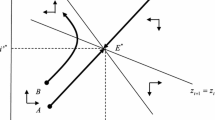Abstract
The paper models the dual role of money balances as a short-run buffer stock and an asset with a well-specified long-run demand function. The analysis is carried out in an open economy framework. Consequently, there will be an offset to monetary policy in the form of induced capital movements, but in our model, it will be distributed over time even under perfect substitutability of financial claims. Estimates for the parameters of the demand for money function are obtained from a capital flow equation using both unrestricted (OLS) and restricted (nonlinear) estimation methods. The results provide strong evidence in favour of the shock-absorption theory for the adjustment of money demand under money supply changes.
Similar content being viewed by others
References
Carr, J., andM.R. Darby: The Role of Money Supply Shocks in the Short-Run Demand for Money. Journal of Monetary Economics8, 1981, 183–199.
Chow, G.C.: On the long-run and short-run demand for money. Journal of Political Economy74, 1966, 111–131.
Coats, W.L. Jr.: Modelling the Short-Run Demand for Money with Exogenous Supply. Economic InquiryXX, 1982, 222–239.
Feige, E.L.: Expectations and adjustments in the monetary sector. American Economic Review, Papers and Proceedings57, 1967, 462–473.
Friedman, M.: The Demand for Money: Some Theoretical and Empirical Results. Journal of Political Economy67, 1959, 327–351.
Goldfeld, S.M.: The case of the missing money. Brookings Papers on Economic Activity3, 1976, 683–730.
Goodhart, C.A.E.: Monetary Trends in the United States and the United Kingdom: A British Review. Journal of Economic LiteratureXX, December 1982, 1540–1551.
Goodhart, C.: Disequilibrium Money — A Note. Unpublished.
Hein, S.E.: Short-Run Money Growth Volatility: Evidence of Misbehaving Money Demand? Review, Federal Reserve Bank of St. Louis, June/July 1982.
Kanniainen, V., andJ. Tarkka: The Demand for Money: Microfoundations for the Shock-Absorption Approach. Bank of Finland, Research Department, Research Papers 7, Helsinki 1983.
Kouri, P.J.K., andM.G. Porter: International Capital Flows and Portfolio Equilibrium. Journal of Political Economy82, 1974, 443–467.
Laidler, D.: The Demand for Money in the United States — Yet Again. Carnegie-Rochester Conference Series on Public Policy12, 1980, 219–271.
-: The Buffer Stock Notion in Monetary Economics. Department of Economics, The University of Western Ontario, Research Report 8313, 1983.
MacKinnon, J.G., and R.D. Milbourne: Monetary Anticipations and the Demand for Money. December 1982, unpublished.
Obstfeld, M.: Sterilization and the Offsetting Capital Movements. Evidence from West Germany, 1960–1970. NBER working paper series No. 494, 1980.
Author information
Authors and Affiliations
Additional information
We are indebted to an anonymous referee for helpful comments. Financial support from the Research Foundation of the Co-operative Banks is gratefully acknowledged.
Rights and permissions
About this article
Cite this article
Kanniainen, V., Tarkka, J. The role of capital flows in the adjustment of money demand: The case of Finland. Empirical Economics 9, 75–85 (1984). https://doi.org/10.1007/BF01969388
Received:
Revised:
Issue Date:
DOI: https://doi.org/10.1007/BF01969388




